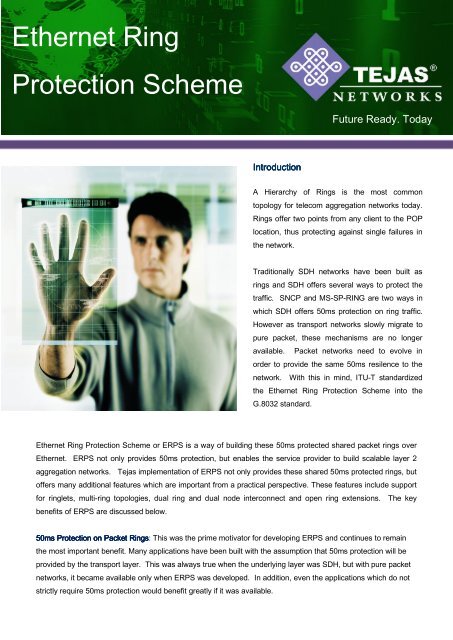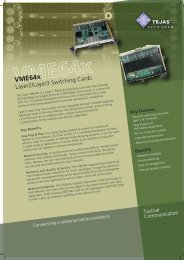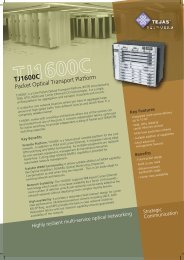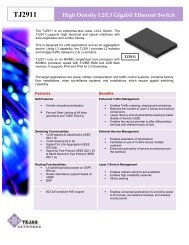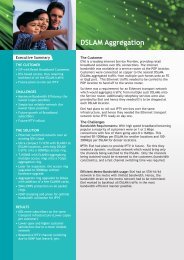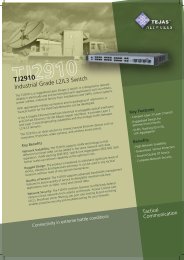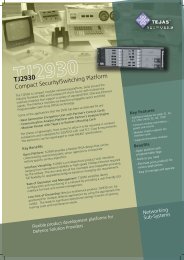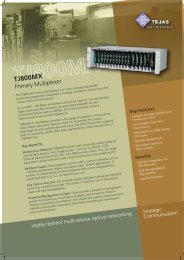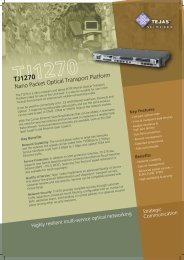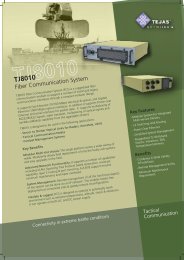Ethernet Ring Protection Scheme - Tejas Networks
Ethernet Ring Protection Scheme - Tejas Networks
Ethernet Ring Protection Scheme - Tejas Networks
You also want an ePaper? Increase the reach of your titles
YUMPU automatically turns print PDFs into web optimized ePapers that Google loves.
<strong>Ethernet</strong> <strong>Ring</strong><br />
<strong>Protection</strong> <strong>Scheme</strong><br />
Future Ready. Today<br />
Introduction<br />
A Hierarchy of <strong>Ring</strong>s is the most common<br />
topology for telecom aggregation networks today.<br />
<strong>Ring</strong>s offer two points from any client to the POP<br />
location, thus protecting against single failures in<br />
the network.<br />
Traditionally SDH networks have been built as<br />
rings and SDH offers several ways to protect the<br />
traffic. SNCP and MS-SP-RING are two ways in<br />
which SDH offers 50ms protection on ring traffic.<br />
However as transport networks slowly migrate to<br />
pure packet, these mechanisms are no longer<br />
available. Packet networks need to evolve in<br />
order to provide the same 50ms resilence to the<br />
network. With this in mind, ITU-T standardized<br />
the <strong>Ethernet</strong> <strong>Ring</strong> <strong>Protection</strong> <strong>Scheme</strong> into the<br />
G.8032 standard.<br />
<strong>Ethernet</strong> <strong>Ring</strong> <strong>Protection</strong> <strong>Scheme</strong> or ERPS is a way of building these 50ms protected shared packet rings over<br />
<strong>Ethernet</strong>. ERPS not only provides 50ms protection, but enables the service provider to build scalable layer 2<br />
aggregation networks. <strong>Tejas</strong> implementation of ERPS not only provides these shared 50ms protected rings, but<br />
offers many additional features which are important from a practical perspective. These features include support<br />
for ringlets, multi-ring topologies, dual ring and dual node interconnect and open ring extensions. The key<br />
benefits of ERPS are discussed below.<br />
50ms <strong>Protection</strong> on Packet <strong>Ring</strong>s: This was the prime motivator for developing ERPS and continues to remain<br />
the most important benefit. Many applications have been built with the assumption that 50ms protection will be<br />
provided by the transport layer. This was always true when the underlying layer was SDH, but with pure packet<br />
networks, it became available only when ERPS was developed. In addition, even the applications which do not<br />
strictly require 50ms protection would benefit greatly if it was available.<br />
1
For eg, if the downtime was more than 200ms, TCP will reduce it’s window size and slow down the<br />
rate at which it is pumping traffic, thinking that there is congestion in the network. Even though the full<br />
bandwidth is restored after 200ms, the applications will experience slow connections, for next several<br />
seconds or minutes, until TCP restores it’s window size. These have implications on Gaming, jitter in<br />
Voice and Video traffic and Frame Relay and ATM might reroute traffic.<br />
If the downtime exceeds 2 seconds, TCP timeouts will happen and routing protocols will get affected.<br />
In case of more than 10 seconds, all sessions get terminated and routing table reconvergence<br />
happens.<br />
RSTP/MSTP vs ERPS: Spanning Tree Protocols are perhaps the most common method of protecting<br />
<strong>Ethernet</strong> meshed networks, is to use RSTP. RSTP suffers from several limitations, some of which<br />
include high convergence times ( 2s to 10s), limitation on network size ( maximum of 7 hops).<br />
Comparison<br />
RSTP/MSTP<br />
ERPS<br />
Convergence Time 2s to 10s 50ms<br />
<strong>Ring</strong> Size Max of 7 No limit<br />
Fault Localization<br />
No (Traffic on entire RSTP<br />
domain gets affected)<br />
Yes (Traffic only on the failed<br />
ring gets affected)<br />
In order to overcome these limitations, the service providers who deployed <strong>Ethernet</strong> in the<br />
Aggregation <strong>Networks</strong>, used to keep them small and segregated them using Routers. However this is<br />
no longer necessary and complete end-to-end <strong>Ethernet</strong> <strong>Networks</strong> can be built, primarily due to ERPS.<br />
<strong>Ring</strong>lets for Effective Bandwidth Utilization: <strong>Tejas</strong> supports segregation of the physical ring into<br />
multiple logical rings or ringlets. This enables protected and unprotected traffic to co-exist on the<br />
network. Also different scheduling and QoS policies can be applied to different ringlets. A <strong>Ring</strong>let is a<br />
logical ring into which different VLAN IDs or groups of VLAN IDs can be added and the entire bundle<br />
is treated as one logical ring. One key advantage of having ringlets is that different ringlets can block<br />
different spans of the ring for loop avoidance. So although one ringlet will use only one side of the<br />
ring, but with many ringlets, both sides of the ring get fully utilized. This leads to doubling of the<br />
bandwidth available on the packet ring.<br />
2
Multi <strong>Ring</strong> Support: <strong>Ring</strong>s are seldom built as standalone entities. Most networks consist of a<br />
hierarchy of interconnected rings. Some of these might share two nodes in common ( Dual Node), or<br />
might have a single node subtending two rings. The protection requirements of these differ slightly<br />
and need to be supported by ERPS. <strong>Tejas</strong> implementation supports all of these scenarios and<br />
handles the corner cases cleanly.<br />
3
Open <strong>Ring</strong> Extensions: Mostly the gateway or aggregation router is configured in a<br />
redundant topology. The traffic from the aggregation network can reach both the active<br />
and standby router, and in case of a failure, all the traffic needs to be switching to the<br />
standby router. <strong>Tejas</strong> supports these use cases through it’s open ring extensions to ERPS.<br />
To summarize, ERPS enables 50ms protection, bandwidth efficiency, scalability of the<br />
Layer 2 network and more operator control over the network. Thus, ERPS support is a<br />
must have for any Carrier Class Layer 2 <strong>Networks</strong>.<br />
4<br />
10111512


